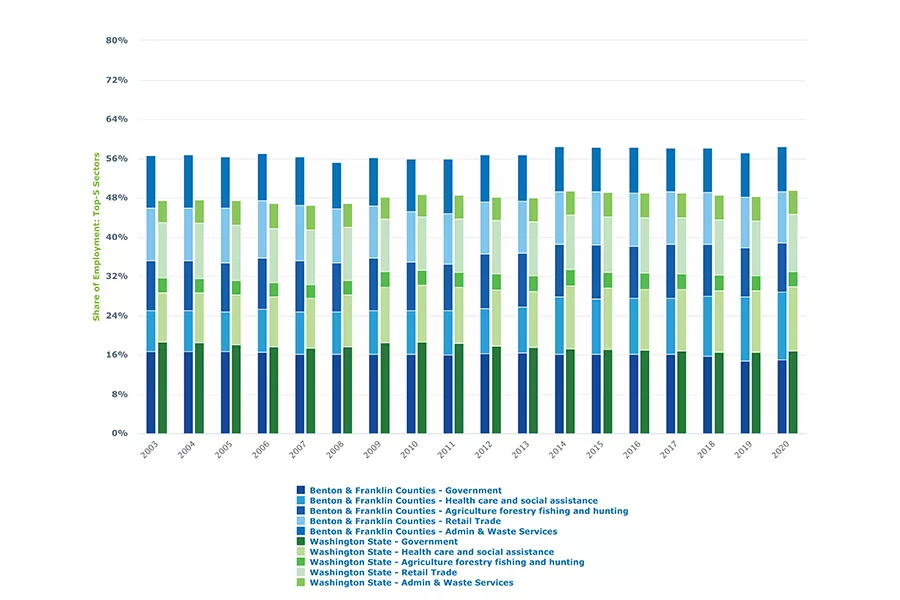
Home » Tri-City health care has grown fast. Can the workforce keep up?
Tri-City health care has grown fast. Can the workforce keep up?

February 11, 2022
If there’s an economic competition at play in Benton and Franklin counties, the winning sector for the century to-date is health care.
At least, if we measure performance by the number of people employed.
As Benton-Franklin Trend data illustrates, health care’s share of the two-county workforce clocked in at 13.8% in 2020. Compare that to its 2003 standing of 8.3%. It is now the second-largest sector in the local economy and no other sector in the greater Tri-Cities has grown as fast.
Washington’s Employment Security Department (ESD) put the average headcount in 2020 at 16,650. Since 2003, the number of people employed in health care has more than doubled, or increased by 121%. The only other sector that has come close matching such long strides has been construction, increasing its headcount by 114%.
Why and how has this happened? One reason lies in local health care simply catching up to the rest of the state.
Early in the decade of the 2000s, health care here was likely “undersized,” compared to the state. Throughout all of Washington in 2003, health care took up 10%.
So now the relationship is reversed: health care in the greater Tri-Cities is relatively more important than throughout Washington.
Another reason can likely be traced to the rapid population growth in the area. As the Trends population data shows, over that same two decades the two counties gained about 98,000. This singled out the area as the fastest growing in the state. With a substantially larger population comes a greater need for specialty care. We have no measure that confirms this, but it seems highly likely that much of the growth has come from tertiary care providers.

A third reason can be tied to the graying of the greater Tri-Cities. The area, as we’ve noted in prior columns, sports a median age that is far lower than that of the U.S. or Washington. But as other data shows, the share of the population age 65+ has picked up over this century. Between 2003-20, the percentage of seniors living in the two counties has climbed from 9.8% to 14.5%. It’s undeniable that as we age we consume more health services, very often from specialists.
Which occupations make up this workforce? We have a good idea, thanks to the ESD’s Occupation Employment & Wages Statistics (OEWS) survey.
According to the most recent survey (2021, based on 2020 responses), the largest health care occupation wasn’t physicians or nurses, but home health care aides. Registered nurses ranked second, however. Nursing assistants followed.
It appears that the category of physicians took fourth place, with a reported 866 of MDs or ODs. We write “appear” because the source, Office of Financial Management (OFM), is different. And it may count some physicians who remain licensed but are not practicing. Rounding out the top five occupations in the sector were medical assistants.
The growth of the sector did not appear let up in 2021, no surprise in a pandemic year. The ESD tracks jobs wanted for every county in the state and publishes the top 25 results monthly. The tallies are based on the Conference Board’s web-scraping of real time online job ads.
For the year January through August, health care openings made up slightly over 20% of the top 25 openings in the two counties. Leading the help wanted list every month were registered nurses, followed by nursing assistants. In third place for health care openings most months were health service managers. Licenses practical nurses followed. Interestingly, physicians rarely appeared on the list.
And the future? For sure, demand will continue to be strong.
As of 2017, demographers at OFM predicted an increase of nearly 50,000 between 2021-30. It is this columnist’s hunch that when the next estimates are released later this year, for Growth Management Act purposes, the number will nudge up a bit.
Think of this forecast as a new town over 50,000 materializing in the two counties over the next decade. Then imagine how many professionals will be required to provide the level of health care we are accustomed to.
Further, add the pandemic effects on the health care workforce to the population forecast. As is well-known, caregivers and especially nurses, are leaving the field due burnout. Let us hope that greater masking and vaccinating efforts lead to a pullback of the crush at local hospitals in the near future and ensuing resignations. But undoubtedly some caregivers, especially those of retirement age, aren’t likely coming back.
So the health care sector, now the second-largest and possibly the largest in a decade, will confront a yawning gap between workforce needs and supply.
Let us hope that the gap will narrow so that patient care will not be compromised.
Patrick Jones is the executive director for Eastern Washington University’s Institute for Public Policy & Economic Analysis. Benton-Franklin Trends, the institute’s project, uses local, state and federal data to measure the local economic, educational and civic life of Benton and Franklin counties.
Health Care
KEYWORDS february 2022





